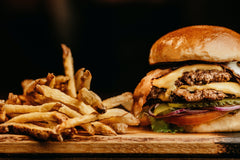
Why We Need to Futureproof Our Food
According to a report by Knorr and the WWF, 75% of our calorie intake in the Western world comes from just 12 crops and five animals. While that’s a staggering thought, the reality of it is even more concerning. Having such a limited nutritional intake is problematic for many reasons including a reduced diversity in our nutrition. It also means fewer plants that are more vulnerable to climate volatility, pests and diseases, and it poses significant challenges for the farmers who grow them. Our reliance on such a narrow pool of nutrition wasn’t always the case, with our ancestors reported to regularly eat 300 different types of plants. And given there are around 300,000 plants that are fit for human consumption, the future is more promising.
Why is it problematic for our health?
A huge problem with intensively farmed crops that are produced on a mass scale, is that many micronutrients are often removed during processing, leaving us with foods that are mostly calorific but without much nutritional value. Of the 12 crops eaten regularly, the big four–wheat, rice, sugarcane and corn–are high in carbohydrate and low in protein. And that’s before they’ve been processed.
Why is it problematic for the global economy?
Producing crops on a global scale means streamlining and standardisation is essential. Not only is that bad news for our health, relying on single varieties of crop is a risky business when you consider threats from disease, extreme weather and other potentially threatening external factors. It also means intense competition between farmers who grow the same thing, with many falling victim to simplified supply chains and competitive pricing.
How to futureproof our food
The simple way to ensure a healthier future for us and the planet is to diversify the foods we eat. The Future 50 Foods is the solution proposed by the report and are foods that have been chosen in accordance with the Food and Agricultural Organization’s (FAO) definition of sustainable diets. As well as having a high nutritional value the foods on the list have limited environmental impact, are high in flavour, accessibility and affordability.
What are the Future 50 Foods?
Algae like laver and wakame seaweed are overlooked nutritional powerhouses. Responsible for half of all oxygen production on earth, they are critical to all the ecosystems of the marine world. From a nutritional perspective they contain essential fatty acids, are an excellent source of antioxidants and are often rich in protein.
Grains like amaranth a great alternative to wheat and corn. Packed with fibre, they’re a sustainable option too because the plant that the amaranth seed comes from can be grown at elevation without the need for lots of water. High in magnesium and protein, it’s great in dishes like stews, soups and risottos.
Another good grain to try is teff, which is fast becoming known as the next super grain. A tiny grass seed that’s a long-standing staple in Ethiopia, teff is an excellent source of iron, calcium, magnesium and manganese. As well as its nutritional value, teff is a hardy plant and can resist challenging climates and pests. Because it has a relatively mild flavour, teff can be used in both sweet and savoury dishes.
Beetroot is already a part of many Western diets, but beet greens are often overlooked and unused but are the most nutritious part of the plant. With a flavour and nutrition profile similar to that of Swiss chard, beet greens are rich in vitamins K and A and contain more magnesium and potassium than similar greens like mustard greens, which essential for functions in the body like blood glucose control. Beet greens also contain as much iron as spinach, as well as the plant pigment lutein, which is associated with good eye health.



